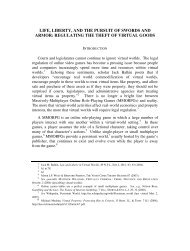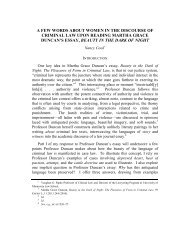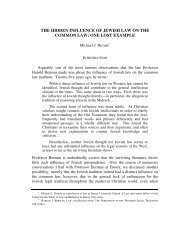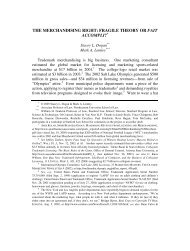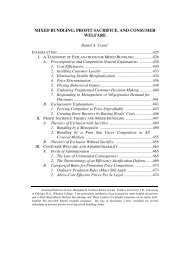Chimera and the Continuum of Humanity - Emory University School ...
Chimera and the Continuum of Humanity - Emory University School ...
Chimera and the Continuum of Humanity - Emory University School ...
Create successful ePaper yourself
Turn your PDF publications into a flip-book with our unique Google optimized e-Paper software.
376 EMORY LAW JOURNAL [Vol. 55<br />
Beyond speciesism, <strong>the</strong> “species” concept itself has been criticized as being<br />
inherently flawed as a scientific distinction. 216 Even putting aside modern<br />
biotechnology, <strong>the</strong> species concept is merely a convenient mechanism by<br />
which to group life forms that are evolutionarily related to varying degrees. 217<br />
Never<strong>the</strong>less, <strong>the</strong> line between humans <strong>and</strong> animals has importance as a moral<br />
<strong>and</strong> social construct; “we rely on <strong>the</strong> notion <strong>of</strong> fixed species identities <strong>and</strong><br />
boundaries in <strong>the</strong> way we live our lives <strong>and</strong> treat o<strong>the</strong>r creatures, whe<strong>the</strong>r in<br />
decisions about what we eat or what we patent.” 218 <strong>Chimera</strong> technology<br />
strongly challenges <strong>the</strong>se notions <strong>of</strong> “fixed species identities.” 219 The gap<br />
between our moral concept <strong>of</strong> a fixed, unique human species <strong>and</strong> <strong>the</strong> modern<br />
scientific reality <strong>of</strong> chimera technology has left us with an inadequate moral<br />
framework. 220 This decoupling <strong>of</strong> <strong>the</strong> moral concept <strong>of</strong> personhood from <strong>the</strong><br />
biological concept <strong>of</strong> humanness will, according to some commentators, lead<br />
to moral ambiguity. 221 Thus, we must be open to a more flexible moral<br />
framework, one that does not rely only on drawing sharp distinctions between<br />
humans <strong>and</strong> nonhumans.<br />
considered a “subordinate <strong>and</strong> inferior class <strong>of</strong> beings” at <strong>the</strong> time that <strong>the</strong> Constitution was framed); RICHARD<br />
KLUGER, SIMPLE JUSTICE 38 (1975) (stating that “north <strong>and</strong> south, he [<strong>the</strong> black man] was classified as a lower<br />
form <strong>of</strong> human life <strong>and</strong> <strong>the</strong>refore fair game for continual debasement”); Rachel E. Fishman, Patenting Human<br />
Beings: Do Sub-Human Creatures Deserve Constitutional Protection?, 15 AM. J.L. & MED. 461, 468–69<br />
(1989) (stating that “[e]arly geneticists believed that qualities such as intelligence, industry <strong>and</strong> righteousness<br />
were linked to genetic endowment <strong>and</strong> would predict race, ethnicity, physical h<strong>and</strong>icap <strong>and</strong> social class. The<br />
risks <strong>of</strong> racism have thus long been associated with genetic research”). But see David Wasserman, Species <strong>and</strong><br />
Races, <strong>Chimera</strong>s, <strong>and</strong> Multiracial People, AM. J. BIOETHICS, Summer 2003, at 13, 13 (distinguishing racial<br />
classifications <strong>and</strong> arguing that moral lines between humans <strong>and</strong> chimera should be maintained).<br />
216 David Castle, Hopes Against Hopeful Monsters, AM. J. BIOETHICS, Summer 2003, at 28, 28; see<br />
Robert & Baylis, supra note 43, at 3 (“[A]t present, <strong>the</strong>re are somewhere between nine <strong>and</strong> twenty-two<br />
definitions <strong>of</strong> species in <strong>the</strong> biological literature. Of <strong>the</strong>se, <strong>the</strong>re is no one species concept that is universally<br />
compelling.”).<br />
217 Robert & Baylis, supra note 43, at 2–4.<br />
218 Id. at 6. While animals are not afforded constitutional rights, society has recognized <strong>the</strong> special moral<br />
status <strong>of</strong> certain intelligent animals. For instance, <strong>the</strong>re are strict limitations <strong>and</strong> requirements for primate<br />
research. Castle, supra note 216, at 29.<br />
219 Robert & Baylis, supra note 43, at 2.<br />
220 Id.<br />
221 Id. However, it is not clear that Robert <strong>and</strong> Baylis believe that this threat <strong>of</strong> moral ambiguity is<br />
sufficient to make it immoral or unethical to produce chimera. In response to Robert <strong>and</strong> Baylis, o<strong>the</strong>rs have<br />
argued that affording special moral st<strong>and</strong>ing to certain chimera would not actually threaten society’s moral<br />
structure. Siegel, supra note 200, at 34. This is because in <strong>the</strong> “extraordinary instance” where a chimera<br />
might exhibit high-level cognitive abilities, we would be able to accord it special respect without changing <strong>the</strong><br />
firmly entrenched idea that human life is sacred <strong>and</strong> distinct from o<strong>the</strong>r animals. Id. The extent <strong>of</strong> this<br />
“special respect,” however, is undetermined because while humans do possess a framework for underst<strong>and</strong>ing<br />
our moral obligations to chimera, society still needs to determine which “properties are relevant to moral<br />
status” <strong>and</strong> “whe<strong>the</strong>r chimeras possess <strong>the</strong> relevant moral properties.” Id.





